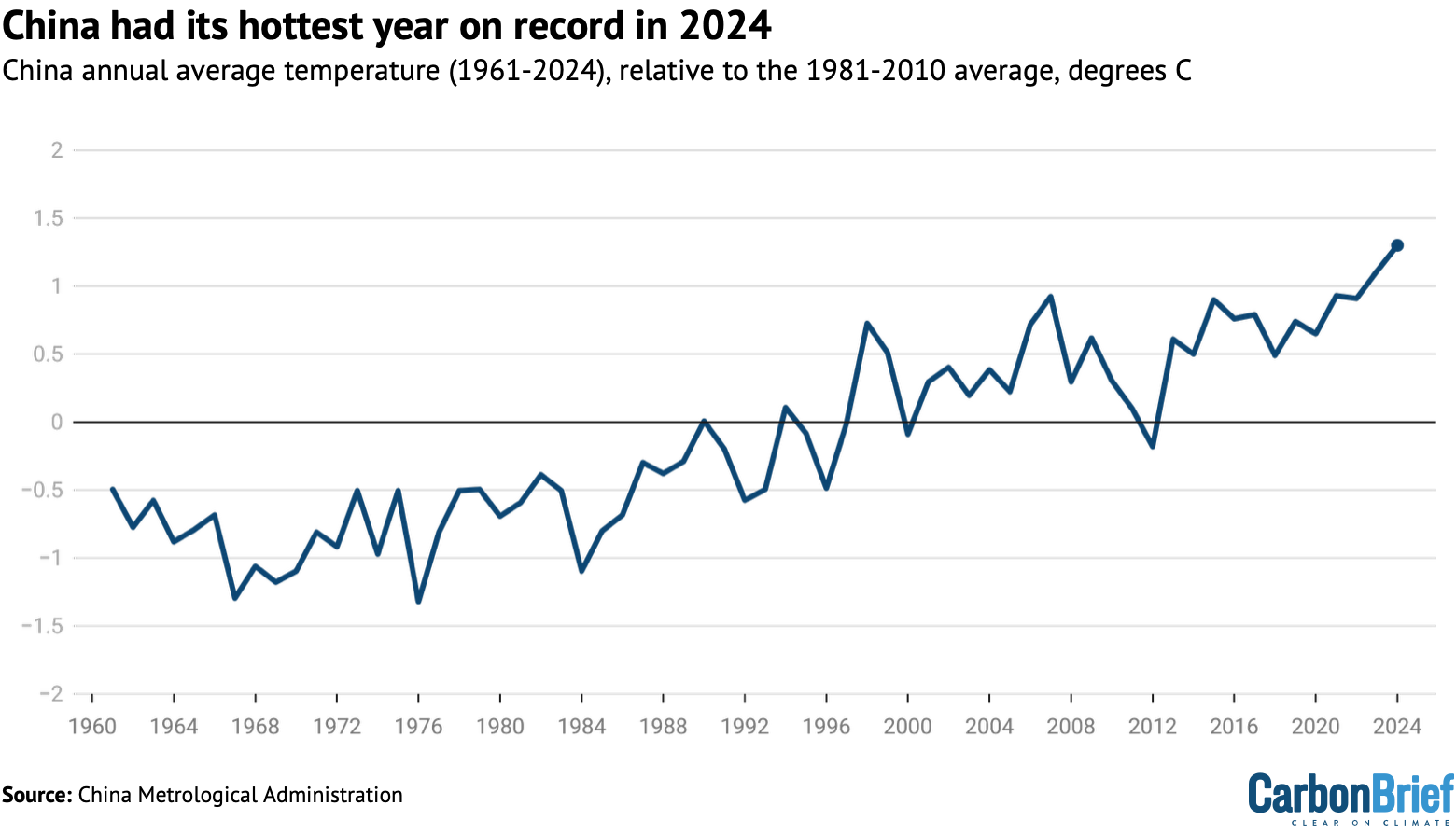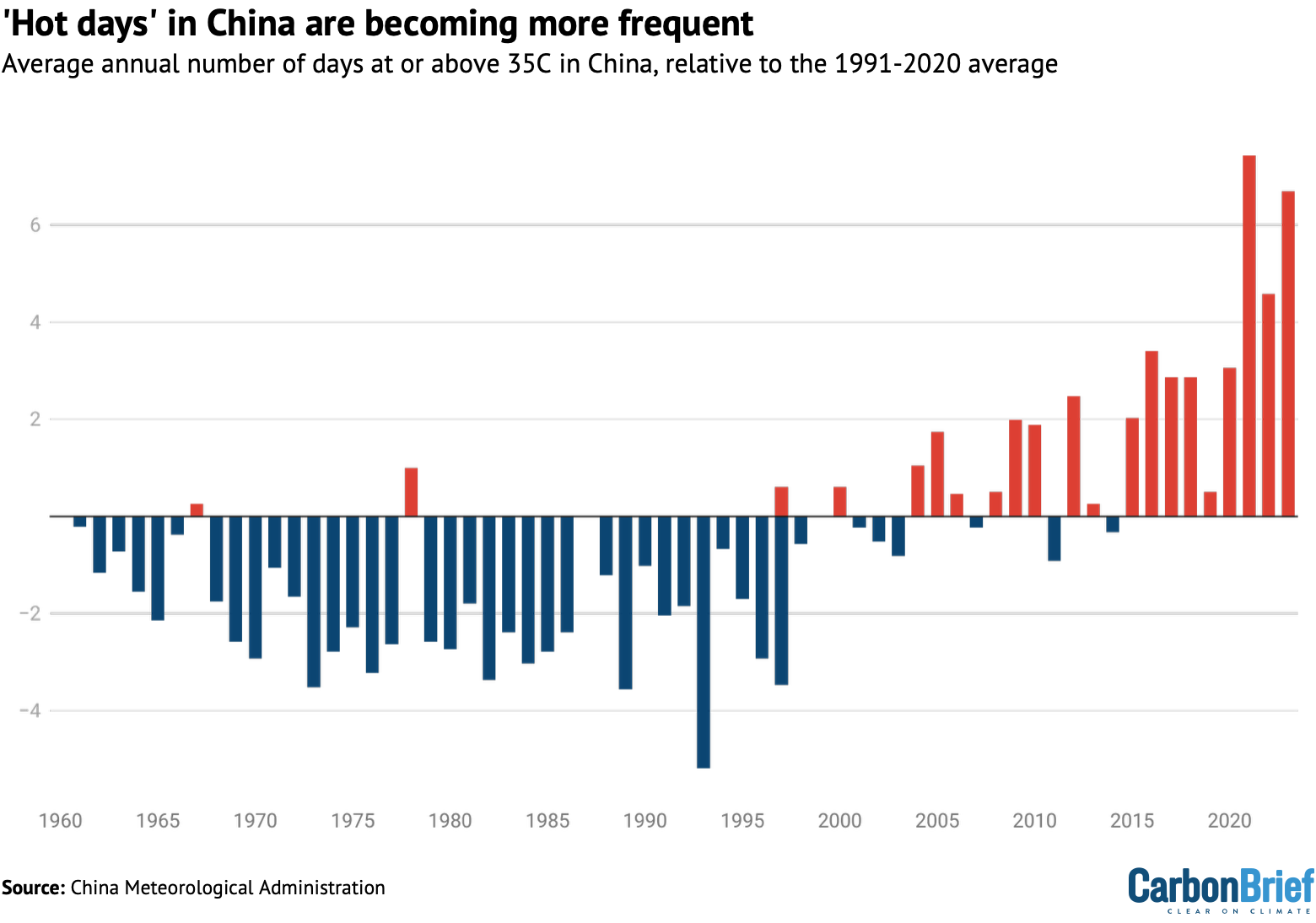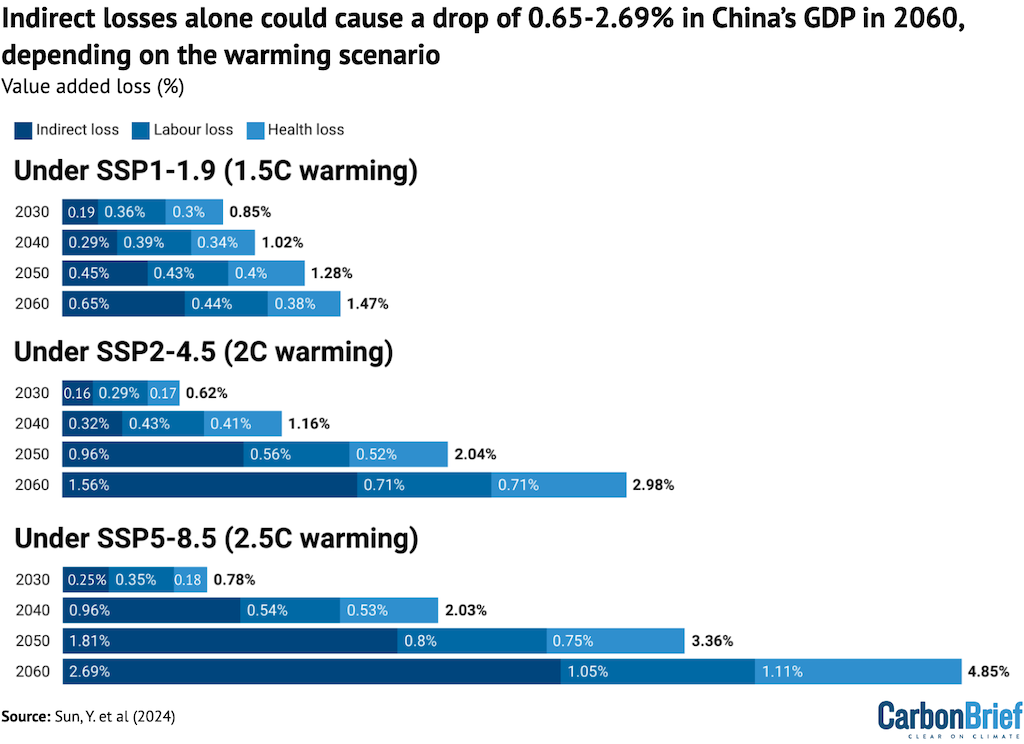China has seen a series of temperature records broken this summer, as heatwaves have struck various regions across the country.
Between mid-March and mid-July 2025, it was hit by an unprecedented number of “hot days” – where temperatures reach or exceed 35C – according to the China Meteorological Administration (CMA) .
In both May and June, heatwaves swept across northern regions, with temperatures in Xinjiang reaching as high as 46.8C.
Such a record-breaking summer is becoming increasingly common, with the CMA’s annual Climate Bulletins showing that hundreds of local heat records have been surpassed over the past decade.
The CMA says that “extreme high temperatures” have shown an “increasing trend” in China since its records began in 1961.
Experts tell Carbon Brief that heatwaves strongly affect public health, agricultural output and economic activity.
They also put significant strain on the electricity system.
In this Q&A, Carbon Brief looks at how heat extremes are changing in China, the role of climate change in making these worse and how the country is adapting to the impacts.
How are heat extremes changing in China?
The latest science report from the Intergovernmental Panel on Climate Change (IPCC) states that it is “virtually certain” that “the frequency and intensity of hot extremes have increased” across the world since 1950.
The IPCC adds that it is “virtually certain” that human-caused greenhouse gas emissions are “the main driver”.
China is no exception. In a press release for its latest 2025 “blue book on climate change in China”, the CMA says China is “susceptible to the impacts of global climate change”, noting:
“[China’s] warming rate is higher than the global average…and extreme weather and climate events are becoming more frequent and intense.”
Data from the CMA’s Climate Bulletins show how the average annual temperature in China is rising and how 2024 was the hottest year on record, as shown in the chart below.

While 2024 was the hottest year on record overall, this was a result of consistently high temperatures throughout the seasons.
At a CMA press conference in 2025, Chan Xiao, deputy director of the CMA commented:
“Temperatures were consistently high throughout the year, with significant fluctuations in temperature during winter. Spring, summer and autumn temperatures were all record highs for the same period.”
In contrast, more heat records were broken during 2022, even though it was not quite as hot overall. Explaining this, Prof Yang Chen from Chinese Academy of Meteorological Sciences, which falls under the CMA, tells Carbon Brief:
“[For] the annual mean air temperatures, every day counts. So even if the 2022 was exceptional for its large number – actually also very long duration-consecutive days and high-magnitude – of hot extremes, mainly during summer and in the Yangtze River Valley, it does not mean the remaining days were hotter than the counterparts in 2024.”
The CMA defines a “hot day” or “high temperature day” as one that reaches or exceeds 35C. It adds that “high temperatures for several consecutive days constitute a heatwave”.
As the global climate has warmed, the number of “hot days” that China is experiencing has been on the rise, shown in the figure below.

The year 2022 set a new record, with meteorological stations in China recording an average of 16.4 hot days. This was 7.3 more than the average for 1991-2020. The year 2024 came close to this record, with 15.6 hot days. These two years have also seen China’s hottest summers on record.
In 2022, more than 1,000 meteorological stations in China reported heatwaves, with 441 breaking “historical records”. For 2024, 74 stations reported “consecutive high temperature days” and 81 of them broke records.
Xiao said at a press conference in 2023 that “continuous high temperatures” in China’s central and eastern regions lasted for 79 days in the summer of 2022. The provinces of Gansu and Xinjiang in north-west China, Hubei in central China and Sichuan in south-west China all reported their “highest temperatures since 1961”.
In addition, the “maximum daily temperature [in the summer of 2022] at 361 national meteorological stations – accounting for 14.9% of the total number of stations in the country – reached or exceeded historical extremes”, Xiao added.
The CMA has also highlighted that summer is arriving earlier for much of China. In 2024, for example, summer in regions including most of Hainan province in south China, central Yunnan province in south-west China as well as central and southern Xinjiang province in north-west China arrived more than 20 days earlier than average.
“If a year’s spring and summer are longer, the potential heatwaves…will also be longer,” Prof Wenjia Cai, from the department of earth system science of Tsinghua University, tells Carbon Brief.
Cai notes that there are more ways to define heatwaves than CMA’s absolute threshold of 35C.
For example, a heatwave can also be defined by how long the hot weather persists, or based on “the daily maximum temperature, daily average temperature, or even nighttime temperature”, she tells Carbon Brief.
However, regardless of the definition used, the “number of heatwave days is definitely increasing as a result of climate change”, she adds.
What role does human-caused climate change play?
A field of climate science called “attribution” has emerged over the past two decades to establish the role that human-caused warming plays in individual extreme weather events, including heatwaves, floods, droughts and storms.
Attribution studies can also be used to find the “fingerprint” of human-caused climate change in longer-term trends, such as the gradual increase in surface temperatures over multiple decades.
Heat is the most-studied extreme event in attribution literature, as it is mainly driven by thermodynamic influences – in other words, it is relatively easy to study.
In contrast, storms and droughts are more strongly affected by complex atmospheric dynamics and, as such, can be trickier to simulate in a model. Cai tells Carbon Brief:
“High temperature is the most obvious trend against the background of climate change. Heatwaves, in comparison to events such as rainfall and typhoons, are also more predictable.”
Carbon Brief has produced an interactive map showing every attribution study published up to November 2024. In total, 114 extremes and trends in China have been the subject of an attribution study, including more than 20 relating specifically to extreme heat.
One study included on the map looks at the change in the intensity and frequency of extreme temperatures across China over 1951-2018. The authors say that, over this time period, “more intense and more frequent warm extremes” were observed across “most regions” in China – and that “greenhouse gas forcing plays a dominant role” in this.
Looking at individual extreme events, one analysis by the “rapid attribution” group World Weather Attribution investigates the then-record-breaking heat across China in July 2023. The analysis says that temperatures exceeded 50C in north-west China, adding that Sanbao, in Xinjiang, hit 52.2C on 16 July of that year.
The study finds that, in a world without climate change, such an extreme heat event would have been “extremely rare” and would only have happened once every 250 years. However, in today’s climate, as a result of human-caused climate change, a heatwave of this intensity is now expected once every five years.
This means China’s extreme heat of July 2023 was 50 times more likely due to climate change. The study also finds that in a world without climate change, the heatwave over China would have been 1C cooler.
A separate study finds that human-caused climate change also caused a more than 60-fold increase in the likelihood of the extremely warm 2013 summer, compared to the early 1950s.
It adds that other factors such as urbanisation and changes in atmospheric circulation patterns can also make heat extremes more intense and frequent.
What impact are these heatwaves having?
Heatwaves have a wide variety of impacts on human activities, such as public health, crop yields and economic output.
Older people are particularly vulnerable to extreme heat. The 2024 report from the Lancet Countdown on Health and Climate Change found that, in 2023, demographic changes alone could have driven a 65% increase in heat-related deaths among over-65s, compared to the 1990-99 average.
Cai, who is also the lead author of the Lancet Countdown’s China report, tells Carbon Brief that older people are the “most commonly mentioned vulnerable group” and that the number of people affected by heatwaves will grow as societies age.
However, heatwaves also “affect outdoor activities” regardless of age group, she adds, as well as having impacts on sleep and allergies:
“We don’t want anyone to think they are in a group of people unaffected by heatwaves.”
Cai says that heat exposure can increase the incidence of certain dangerous behaviours, such as domestic violence, as well as a wide range of diseases – including cardiovascular diseases and respiratory diseases – and mental health disorders.
In 2023, more than 30,000 deaths were related to heatwaves in China – 1.9 times higher than the average over 1986-2005, according to Cai and her colleagues’ China report.
This was a result of increased heat exposure – the average number of “heatwave exposure days” per person reached 16 days in 2023, more than three times the historical average (1986-2005), the report adds.
A 2022 attribution study on China notes that extreme heat can also increase the risk of preterm births. The authors find that over 2010-20, an average of 13,262 premature births were recorded in China due to heatwave exposure. The study linked one-quarter of these early births to climate change.
Another profound impact of heatwaves is that they can exacerbate droughts, with knock-on impacts for agriculture.
Reuters reported last June that “China’s agriculture ministry said…searing temperatures have adversely impacted summer planting and that fighting drought and protecting summer planting were arduous tasks”.
Droughts in 2024 hit more than 11 million people in China, with more than 1.2m hectares of affected crops and direct economic losses topping nearly 8.4bn yuan ($1.2bn), the Ministry of Emergency Management said in early 2025.
Heat-related economic losses could reach nearly 5% of China’s GDP by 2060, according to a recent guest post for Carbon Brief. Authors Prof Guan Dabo and doctoral student Sun Yida from Tsinghua University wrote:
“By 2060, China’s heat-induced economic losses could total about 1.5% of total GDP under 1.5C of global warming, 3% under 2C of warming and 4.9% under 2.5C of warming.”
Those predicted losses include “indirect economic losses”, which “could be due to changes in production, consumption or employment” in the global supply chain, including crop failures and labour slowdowns, they explained.
The figure below, based on their study, shows Chinese GDP losses under three different scenarios of future emissions, called “shared socioeconomic pathways” (SSPs).
The SSP1-1.9, SSP2-4.5 and SSP5-8.5 scenarios project average global temperature rises of around 1.5C, 2C and 2.5C by mid-century, respectively.
Economic losses are split into indirect losses (dark blue), labour losses (blue) and health losses (light blue).

Sectors such as the extractive industries, construction and non-metallic manufacturing “could see the highest losses” of about 4.6-6.4% of their “value-added” – the increase in worth of a product or service as it moves through different stages of production – largely because they are in Chinese “regions with significant warming”, according to Guan and Sun.
Those industries also have close business connections with south-east Asia, Africa and South America, which are “expected to face heightened exposure to production volatility caused by high temperatures”, they add.
The total economic loss globally could reach up to 4.6% by 2060, according to their study, and manufacturing-heavy countries such as China and the US, in particular, could be “strong[ly] hit”.
Other than manufacturing, electricity supplies in China have also been frequently reported to be affected by hot days.
Chinese news outlet China Business Network reports that China’s National Energy Administration said last year that summer was the hardest time to ensure sufficient electricity supply during a year and that extreme weather would make the supply even harder.
For 2025, China’s State Grid Corporation expected maximum electricity demand to exceed 1,200 gigawatts (GW), a new record.
Dr Muyi Yang, senior energy analyst at thinktank Ember, tells Carbon Brief that “when temperatures soar, electricity demand spikes – mainly due to air conditioning – and that can stretch the grid, especially in already tight systems”.
Biqing Yang, energy analyst at Ember, adds:
“In the third quarter of last year, for example, China’s residential electricity consumption rose significantly, by 17.8% year-on-year, largely due to elevated temperatures…It is clear that we are now entering an era [w]here climate change is having a real-time impact on our energy system.”
China’s electricity demand reached a new record in July 2025 after year-on-year growth of 8.6%, consuming more power in one month than Japan did in all of 2024, according to David Fishman, Shanghai-based principal at consultancy the Lantau Group.
The “staggering” July 2025 figures – including another 18% year-on-year rise in residential demand, partly due to rising household incomes, as well as air conditioning use – illustrates the impact of climate change on China’s power sector, Fishman writes on LinkedIn:
“We know it’s hot out and everyone knows every summer the intense heat seems to last for longer and longer. But these power consumption numbers are telling a story about China’s climate patterns like few other datasets can…and it’s a scary story.”
Yang, Chen and Cai tell Carbon Brief that it is important for China to adapt to the rising temperature and intensive heatwaves.
Chen specifically describes “successful” forecasts and early warnings as “critical” , saying that they are the “very first step toward adaptation”.
In his LinkedIn post, Fishman notes that the rapidly rising demand for electricity, including as a result of growing air conditioning use, also poses a “considerable challenge to China’s ability to meet rising demand solely with clean power sources”.
How is China adapting to heatwaves?
In recent years, China has implemented more and more policies aimed at adapting to heatwaves.
For example, weather forecasts and heatwave alerts have been provided.
Central and local governments have also issued labour policies aimed at protecting workers against extreme heat.
Under a policy from the Ministry of Human Resources and Social Security, for instance, outdoor works are not expected to be undertaken when temperatures exceed 40C. In addition, outdoor working hours should be shorter than six hours when the temperature is 37-40C.
Similarly, school students in some cities, such as Wuhan and Chengdu, have been advised to study from home during hot days in recent years.
Since 2021, the city of Tianjian has been sending text warnings of heatwaves to its residents, reminding people of the health risks it poses. The messages, according to Southern Metropolis Daily, warn that strokes might be triggered in the coming hot days and advises people to avoid outdoor activities and take medication if needed.
These text reminders have “significantly” reduced the number of hospitalised people in Tianjin, saving the city 140m yuan ($19.5m) since being introduced, adds the outlet.
In 2013, the central government published its first “national climate change adaptation strategy” – an attempt to implement the “clear requirement” of “enhancing our ability to adapt to climate change” included in the 12th “five-year plan” (2011-15).
In the latest version for 2035, heatwaves appear in sections related to the power sector, as well as agriculture and health.
The strategy aims to “improve” and “reinforce” nationwide “labour protection standards”, as well as “work system[s] that adapt to change and reduce agricultural disasters”. Its purpose is also to ensure the energy and electricity sectors’ abilities to “withstand extreme weather and climate events” in relation to heatwaves.
The strategy says that “health-risk assessment guidelines” and public health-related “implementation plans for adaptation under major extreme weather and climate events”, such as heat and heatwaves,in “various regions”, will be developed.
Last year, following the release of the latest overall adaptation strategy, China published the “national climate change health adaptation action plan (2024-30)”.
Cai calls the document a “very very important” blueprint for health risk management, bringing together a range of organisations, including hospitals, to form a “system related to climate change and health” that has “monitoring and early warning capabilities”.
She adds that this plan will also see heat-health alerts being issued nationwide:
“It is worth mentioning that the National Administration of Disease Control and Prevention and the China Meteorological Administration signed a joint agreement [in May 2025] on issuing [nationwide] health alerts – and that the first product is related to heatwaves.”
Ember’s Yang says that in terms of electricity, China is moving toward building a “‘new electricity system (新型电力系统)’ that is more compatible with high shares of renewables”. But, he adds, the old “planning psychology” needs to change so that it can better cope with extreme heat:
“Traditionally, the mindset has been very supply-driven – just keep adding enough generation and network capacity to meet demand…[With the new system] the demand side has to become an active player – a prosumer – that can actually support grid reliability.
“For example, during extreme heat, instead of just ramping up supply, we should also be encouraging users to reduce or shift their electricity use during peak hours, using price signals or incentives…This is the essence of what we call ‘coordinating generation, grid, load, and storage’ (源网荷储一体化) – a system that works together [and works] more efficiently and flexibly.”
The post Q&A: How China is adapting to ‘more frequent and intense’ heat extremes appeared first on Carbon Brief.
Q&A: How China is adapting to ‘more frequent and intense’ heat extremes
Climate Change
COP30: Carbon Brief’s second ‘ask us anything’ webinar
As COP30 reaches its midway point in the Brazilian city of Belém, Carbon Brief has hosted its second “ask us anything” webinar to exclusively answer questions submitted by holders of the Insider Pass.
The webinar kicked off with an overview of where the negotiations are on Day 8, plus what it was like to be among the 70,000-strong “people’s march” on Saturday.
At present, there are 44 agreed texts at COP30, with many negotiating streams remaining highly contested, as shown by Carbon Brief’s live text tracker.
Topics discussed during the webinar included the potential of a “cover text” at COP30, plus updates on negotiations such as the global goal on adaptation and the just-transition work programme.
Journalists also answered questions on the potential for a “fossil-fuel phaseout roadmap”, the impact of finance – including the Baku to Belém roadmap, which was released the week before COP30 – and Article 6.
The webinar was moderated by Carbon Brief’s director and editor, Leo Hickman, and featured six of our journalists – half of them on the ground in Belém – covering all elements of the summit:
- Dr Simon Evans – deputy editor and senior policy editor
- Daisy Dunne – associate editor
- Josh Gabbatiss – policy correspondent
- Orla Dwyer – food, land and nature reporter
- Aruna Chandrasekhar – land, food systems and nature journalist
- Molly Lempriere – policy section editor
A recording of the webinar (below) is now available to watch on YouTube.
Watch Carbon Brief’s first COP30 “ask us anything” webinar here.
The post COP30: Carbon Brief’s second ‘ask us anything’ webinar appeared first on Carbon Brief.
Climate Change
Global Goal on Adaptation: Weighing the cow won’t make it fatter
Mohamed Adow is the Founder and Director of Power Shift Africa
A sobering truth hangs over the COP30 climate talks in Belém: negotiators are discussing adaptation indicators with the enthusiasm of technocrats while quietly starving frontline communities of the resources they need to survive.
The UN’s latest adaptation gap report could not be clearer. Needs are skyrocketing. Finance is collapsing. And yet the global community continues to debate how to measure progress, rather than how to enable it. They act as if weighing a cow will make it fatter, rather than giving it any food.
This contradiction exposes the heart of the climate crisis: adaptation is not merely a technical challenge; it is a political and moral one. Every finance gap is a justice gap. Behind every unmet target are farmers who cannot plant, families who cannot rebuild, and communities forced into displacement because “resilience” was promised but never delivered.
Adaptation is the difference between dignity and despair. It determines whether societies can endure rising temperatures, intensifying floods, or prolonged droughts — or whether they are pushed beyond the limits of survival.
Yet, as negotiators haggle over the Global Goal on Adaptation (GGA) and its indicators, the foundations needed to achieve these goals are crumbling. How do we talk about climate-resilient development when the means to achieve it are drying up? How do we measure resilience while draining the very resources that make resilience possible?
At COP30, countries must resist the impulse to rush through a weak indicator framework simply to claim progress. This would give us a system that measures activity, not impact. – that measures paperwork, not protection.
Africa is championing a fit for purpose GGA, but some have misunderstood and wrongly accused it of stalling the GGA process. But Africa is not delaying adaptation work. Africa is living adaptation every day. For us, adaptation is not a choice or a policy preference or an interesting side issue. It is an existential threat that is already reshaping livelihoods, economies, and ecosystems.
Africa needs this COP to get the GGA right. What we reject is an approach that turns adaptation into an exercise in reporting rather than a vehicle for survival.
A meaningful GGA must track whether finance actually reaches those who need it, whether technologies are shared equitably, and whether vulnerable countries are being supported to build early-warning systems, climate-resilient infrastructure, water security, and heat-resilient health systems. Without this backbone of finance and technology-sharing by the rich world, adaptation indicators become little more than an empty checklist.
And this is where COP30 stands at a crossroads. If rich countries succeed in pushing through a set of indicators that sideline finance, it will confirm that the world’s poorest are once again being asked to run a race with no shoes. No community can adapt without resources. No farmer can withstand worsening heatwaves without irrigation and drought-resistant seeds. No coastal town can protect its people without early-warning systems and resilient infrastructure. To pretend otherwise is not merely flawed policy; it is a profound injustice.
Some will argue that indicators and finance should remain separate discussions. But this is a fiction. You cannot track progress on adaptation without the means to adapt. Adaptation is where political decisions determine whether people live safely or suffer needlessly.
The world is not short of evidence of this suffering, it is short of political courage. Extreme weather displaces more than 30 million people a year, with Africa bearing the brunt. While communities rebuild with scarce resources, developed countries continue to cut aid or repackage support as loans which shackles poor countries with eye-watering debt. This does not build resilience — it entrenches vulnerability.
The Global Goal on Adaptation will become a white elephant if it is not paired with predictable, grant-based finance. Indicators that pretend adaptation is happening without resourcing it will fail the people they claim to protect. COP30 is the moment to close the distance between science and solidarity: wealthy nations must scale up adaptation finance, share technologies, and support long-term resilience planning.
Until then, the world’s most vulnerable will continue carrying the heaviest burden with the lightest support — a defining injustice of our time.
The post Global Goal on Adaptation: Weighing the cow won’t make it fatter appeared first on Climate Home News.
Global Goal on Adaptation: Weighing the cow won’t make it fatter
Climate Change
COP30 Bulletin Day 7: Brazil outlines options for a possible deal in Belém
Last Monday, to get the COP30 agenda agreed, Brazil promised to hold consultations on four controversial issues: emissions-cutting, transparency, trade and finance. Last night, after most delegates had spent their day off exploring the Amazon, the Presidency released a five-page document summarising what was said in those consultations.
Nothing in that “summary note” has been agreed by countries. But it collects together divergent views and forms the basis of what could become a politically agreed statement (known in the jargon as a cover decision) at the end of the COP. It has three key strands on boosting climate finance, strengthening emissions reductions and tackling trade measures linked to decarbonisation.
It includes the key rhetorical messages the COP30 presidency wants to include – that this is a “COP of Truth”, multilateralism is alive (despite President Trump’s efforts to thwart climate action) and the Paris Agreement is now moving from negotiation to implementation.
On emissions-cutting and the need to raise ambition – sorely lacking after the latest round of national climate plans (NDCs) – the note includes an option to hold an annual review and explore the “opportunities, barriers and enablers” to achieve the global efforts agreed at COP28 in Dubai to triple renewable energy and double energy efficiency by 2030; accelerate action to transition away from fossil fuels; and halt and reverse deforestation. This is essentially where any reference to a roadmap to transition away from fossil fuels could be anchored.
The document also includes proposals to “urge” developed nations to include finance in their NDC climate plans and “encourage” all countries that have set a range of percentage emissions reductions in their NDCs – like the EU’s 66.25-72.5% – to move toward the upper end of the range.
On finance, options include a three-year work programme on provision of finance by wealthy governments and a goal to triple adaptation finance (something the least-developed countries are pushing for) or just repeating the finance goal agreed at COP29 and “noting” a new roadmap to achieve that (which rich nations very much prefer).
There are also various options for how to talk about where climate and trade overlap: an annual dialogue, roundtables, consultations, a new platform or just to keep discussing in the ‘response measures’ strand of climate talks.
Li Shuo, head of the Asia Society Policy Institute’s China Climate Hub, told Climate Home News it was highly significant that – after two years of the issue being buried in climate talks – trade has now been “anchored in the endgame of this COP”.
The various potential outcomes in the summary note could be included in existing agenda items or they could be lumped together into what is usually referred to as a cover text but the Brazilian government would likely prefer to call a “mutirão decision” or a delivery, response or global action plan.
Essentially, after governments ignored the presidency’s pleas not to add contentious items to the agenda, it looks like they could get at least some of what they want by turning those issues into the headline deal from COP30 .

At the start of the high-level segment of the conference on Monday morning, where environment ministers deliver their speeches, UN climate chief Simon Stiell urged governments “to get to the hardest issues fast”.
“When these issues get pushed deep into extra time, everybody loses. We absolutely cannot afford to waste time on tactical delays or stone-walling,” he added.
The presidency consultations on the issues in the note will continue on Monday, along with negotiations on adaptation metrics and a Just Transition Work Programme among others. The COP30 president then plans to convene a “Mutirao” meeting of ministers and heads of delegation on Tuesday “to bring together various outcomes”.
Korea joins coal phase-out coalition at COP30
As fossil fuels have grabbed headlines at COP30, major coal producer South Korea kicked off the second week of the Belém conference with an actual concrete pledge: the country will phase out most of its coal power by 2040.
Operating the seventh-largest coal fleet in the world, Korea announced on Monday that it will join the Powering Past Coal Alliance (PPCA), an initiative launched in 2017 by the UK and Canada to encourage countries to wean themselves off the planet’s largest source of emissions. Oil and gas exporter Bahrain is another new member.
Asian industrial giant Korea said that out of 62 operating coal power plants, it will commit to retiring 40 of them by 2040. The phase-out date of the remaining 22 plants “will be determined based on economic and environmental feasibility”.
Korean Minister of Environment Kim Sung-Hwan said at an event announcing the pledge that the country will play a “leading role” in the energy transition.
“South Korea is known as a manufacturing powerhouse. Unfortunately renewable energy has taken a low share in our power mix, but going forward we are determined to foster renewable energy industries,” he told journalists. “We will show the world that we can create a decarbonised energy transition.”
Asked about a fossil fuel transition roadmap – an idea floated around by many governments in Belém – Sung-Hwan said “humanity and all of the governments should work together to achieve a decarbonised green transition”, adding that “COP30 will be an important momentum”.
UK climate minister Katie White said Korea was taking an “ambitious step”, and that they can “reap the rewards that we are seeing from our own clean energy transition”.
Korea is a major importer of oil and gas. Domestically, it has historically relied on coal for electricity, but the country’s production of the fossil fuel has decreased steadily by 86% in the last 25 years, according to the International Energy Agency (IEA). Their nuclear fleet, on the other hand, has nearly doubled in the same time period.
The post COP30 Bulletin Day 7: Brazil outlines options for a possible deal in Belém appeared first on Climate Home News.
COP30 Bulletin Day 7: Brazil sets out options to reach a deal in Belém
-
Climate Change3 months ago
Guest post: Why China is still building new coal – and when it might stop
-
Climate Change2 years ago
Spanish-language misinformation on renewable energy spreads online, report shows
-
Greenhouse Gases3 months ago
Guest post: Why China is still building new coal – and when it might stop
-

 Greenhouse Gases1 year ago
Greenhouse Gases1 year ago嘉宾来稿:满足中国增长的用电需求 光伏加储能“比新建煤电更实惠”
-
Climate Change Videos2 years ago
The toxic gas flares fuelling Nigeria’s climate change – BBC News
-

 Climate Change1 year ago
Climate Change1 year ago嘉宾来稿:满足中国增长的用电需求 光伏加储能“比新建煤电更实惠”
-

 Carbon Footprint2 years ago
Carbon Footprint2 years agoUS SEC’s Climate Disclosure Rules Spur Renewed Interest in Carbon Credits
-
Renewable Energy4 months ago
US Grid Strain, Possible Allete Sale

















